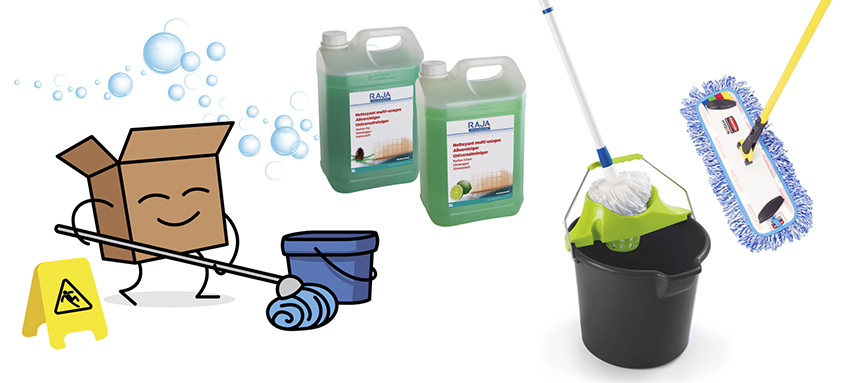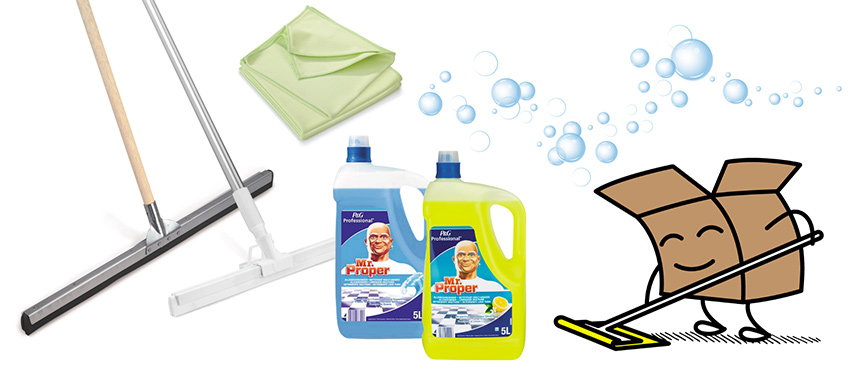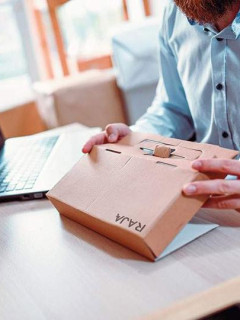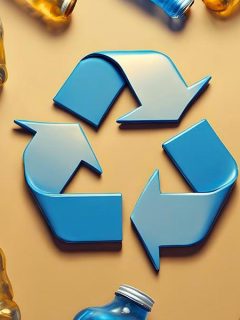Mirror, mirror, tell me who has the best floor in the country? The floors in your company need regular maintenance to keep them in perfect condition. But there’s a catch: there are many different types of floor (parquet, tiles, linoleum, etc.), each requiring its own cleaning method. To clean floors, it’s essential to choose the right cleaner, brush or mop. Read on to find out how to clean your floor effectively, depending on the type of covering.
1. Choose the right cleaning product for washing floors
Those who don’t regularly clean their floors will see dust and dirt build up on them, which is far from ideal forbusiness hygiene. Floors that are not maintained wear out more quickly and need to be replaced. An expense you naturally want to avoid… The solution is simple: clean! And preferably on a regular basis.
That said, each type of floor needs its own special “care”. This starts with choosing the right cleaning product. People who want to clean their floors can choose from the following products:
- Detergents: these surface cleaners remove dirt and organic residues.
- Disinfectants: to eliminate bacteria, viruses and fungi as far as possible.
- Abrasives: to remove stubborn dirt from non-vulnerable surfaces.
- Solvents: for degreasing, sanitising and shining floors.
Note that natural products can be just as effective as chemical solutions. What’s more, they’re less aggressive when it comes to cleaning floors. Here are some common examples.
- The white vinegar is an excellent solution for combating grease, limescale, bacteria and unpleasant odours. In many situations, you can also use it to clean your floors.
- Visit bicarbonate of soda is a champion stain remover and can be used to clean dirty floors.
- The black soap is a degreaser, disinfectant and stain remover. Not only does it clean floors, it also makes them shine again.

2. Adapt to the type of floor covering to clean the floors
Depending on the type of flooring in your business, shop or office, you can choose from the cleaning techniques and solutions below.
2.1 Washing a parquet floor
There are different types of parquet (solid, laminate, waxed, oiled, sealed) – each requiring specific maintenance. But they all have one thing in common: they hate water. Water seeps between the boards and can cause the wood to swell and warp.
Parquet is one of the many floor coverings that are best mopped. First wring it out well, then wipe the floor. For maintenance, you can mix a little black soap or organic washing-up liquid with the water. However, avoid using white vinegar, which could damage the wood. Finally, make sure you vacuum regularly to prevent invaders (such as fleas, ants or termites) from attacking the wood.
Always take care with waxed or oiled floors. They are particularly vulnerable and must not get wet. So don’t wash the floor with water!
2.2 Washing tiles
Tiles are the easiest of all types of floor covering to clean. Simply use an all-purpose cleaner or water mixed with a cup of white vinegar to remove stains quickly. The difficulty, however, lies in the joints between the tiles. It’s important to carefully blot up any water that stagnates between the joints with a dry cloth. This is particularly important in areas of high humidity (such as showers).
It’s best to choose natural products to clean your tiles. Solutions that are too strong, such as bleach, can damage the floor and mar the joints.
2.3 Washing linoleum
Linoleum is a highly flexible floor covering made from organic materials (wood particles, linseed oil, chalk, cork). It requires regular, careful maintenance. To wash the floor, use soapy water mixed with white vinegar. Always remember to wring out the mop well and rinse it regularly to avoid residual marks. Above all, don’t use too much water.
2.4 Washing concrete floors
Originally, concrete floors were only found in car garages or storage areas. Today, they are also used as floor coverings in homes, lofts and trendy offices. It’s an extremely robust material that’s easy to maintain. To clean the floor, simply mop it with water mixed with the desired product (an all-purpose cleaner, for example). For stubborn stains (petrol, oil, etc.), sprinkle the floor with bicarbonate of soda before scrubbing with a stiff brush. It’s important to rinse well afterwards and remove all the water.
2.5 Washing a plastic floor
Plastic floors are generally made of PVC or vinyl. They are widely used in the health, education, hotel and industrial sectors. To clean these plastic floors, it’s best to use a microfibre mop. You can soak the mop briefly in a mixture of water and white vinegar or bicarbonate of soda. In places where hygiene measures are stricter, you may need to use a disinfectant.
Bear in mind that plastic floors do not tolerate aggressive products such as bleach or ammonia. Also avoid using abrasive products (such as scouring cream).
2.6 Washing a carpet
Carpets are often found in hotels, cloakrooms and offices. However, their care and cleaning require special attention. Carpets have an unfortunate tendency to trap dust, hair and crumbs, and are a breeding ground for dust mites, among other things. The best way to clean these floors is with a hoover. Choose a model with enough suction power to get rid of the most stubborn dirt. Once a year, you can opt to clean your carpets with water. Specialist companies offer tailor-made solutions for this.

3. Five frequently asked questions about floor cleaning
3.1 Do I need hot or cold water to mop?
When mopping floors, it’s best to use cold or lukewarm water. Water that is too hot evaporates quickly and leaves cleaning product residues on the floor. These residues can leave marks, making cleaning less effective.
3.2 Can I clean floors with vinegar ?
Vinegar can be particularly useful for cleaning tiled and vinyl floors, as it helps to remove stubborn stains and dirt build-up. However, not all floors are suitable for cleaning with vinegar. Wooden floors and natural stone floors, such as marble and granite, can be damaged by the acidic properties of vinegar. Vinegar is a naturally occurring cleaning agent with powerful acidic properties. You can use it to remove dirt, stains, bacteria and odours.
3.3 When should you use a mop rather than a broom ?
Use a flat mop (with or without a cloth wrapped around it) to clean large, smooth surfaces quickly with water. A mop is ideal for wet or dry cleaning small, hard-to-reach areas and removing stubborn dirt.
3.4 How can I neutralise the smell of a mop ?
Use white vinegar or bicarbonate of soda to freshen the smell of a mop. Vinegar acts as a natural deodoriser and helps remove unpleasant odours from the mop. Add a little white vinegar to a bucket of hot water and soak your mop in it. After washing, rinse the mop with clean water and hang it up to dry.
3.5 What’s the best way to mop ?
The best way to use the mop is to first vacuum the floor. Then lather the mop and wring it out. Run the mop over the floor and rinse it regularly. Leave the floor to dry completely. Always use the right cleaning product for your type of floor and, preferably, cold water to avoid residual marks .













